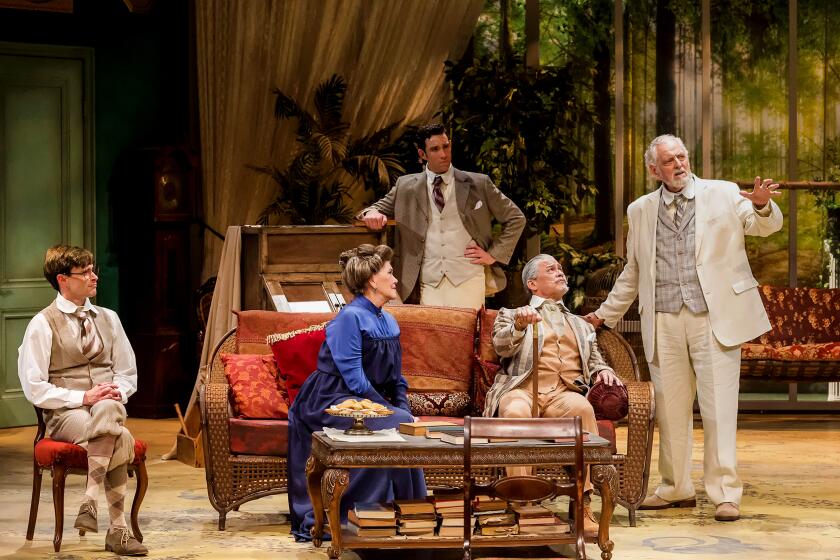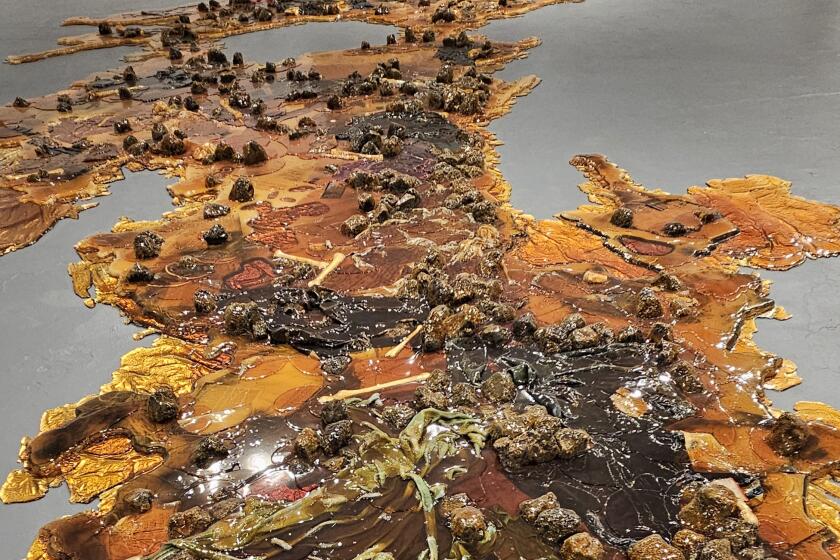Maslow Revisits Her ‘Village’ : Dance Pioneer Restages at UC Irvine a Work About Jewish Ghetto Life
Like millions of other Jews, American modern-dance pioneer Sophie Maslow was horrified by film footage of the Holocaust that emerged after World War II. The tragedy awakened a desire to learn more about her heritage, however, which led her to the stories of Sholom Aleichem.
Aleichem (1859-1916), a Russian Jew who came to the United States in 1914, wrote with humor about daily life in his homeland and the plight of poverty-stricken fellow immigrants. Probably the most widely read Yiddish writer, his prose was translated into many languages.
Maslow had felt uneasy about tackling the Holocaust in a dance, but Aleichem’s work provided the right choreographic impetus. The result was “The Village I Knew,” a 35-minute piece based on his short stories, which she crafted about 40 years ago and has been restaging here during the last two weeks as artist-in-residence at UC Irvine.
Aleichem’s stories were “very positive and full of humor, with an underlying pathos,” Maslow said earlier this week before a rehearsal. His characters “found humor to help (cope with) the tragedy, and that appealed to me because of their continuity of positive living, despite what happens.”
Maslow, who wouldn’t give her age, danced in Martha Graham’s original company in the ‘30s and had her own troupe until the early ‘80s. In late October, the school’s student Dance Ensemble will perform “Village” in a program of classic modern-dance revivals being organized by UCI dance professor Donald McKayle.
“I consider her a real resource,” said McKayle, a former student of Maslow’s who danced in the original “Village” when she premiered it in Connecticut. “There are certain things she can (pass on) that are beginning to disappear. . . . It’s very important to take advantage of her while she’s still with us.”
Maslow formed her own company during her dozen years with Graham, whose technique she never abandoned, either as a dancer or choreographer. In all, she made more than 100 works for opera, theater, television and the concert stage and has been a guest choreographer with groups around the world.
During her Graham tenure, she also teamed up with Jane Dudley and William Bales for the respected Dudley-Maslow-Bales Trio. Dance historian Don McDonagh has said the trio was unafraid of levity, rejecting the “somewhat somber face that modern dance presented to the world in the 1930s.”
Fond of rural Americana and folklore, she drew on barn-dance movement for another famous work, “Folksay” (1942), and designed dances to songs by folk music icon Woody Guthrie (“Dust Bowl Ballads” from 1941). Guthrie embodied the same optimism she found in Aleichem, she said.
“Village,” which she choreographed in two sections in 1949 and 1950, is one of her many works based on Jewish themes and is danced to an original score flavored with folk songs sung in Yiddish. Also heavily influenced by Russian-born artist Marc Chagall’s imagery, it is a series of vignettes about denizens of a Russian ghetto, including a young fiddler, later reincarnated by other minds in “Fiddler on the Roof.”
“It starts with a Sabbath celebration,” McKayle said, “with men in prayer shawls and women preparing a Seder. There’s a section with yeshiva students who study the Talmud, which is beautifully etched like a Chagall painting.”
A long middle section, titled “Festival,” takes place during Simchas Torah, an annual holiday marked by a daylong celebration, Maslow said. “Three miserably poor men get together and go to other people’s homes, taking a little nip at each house, so they’re pretty drunk by the end of the day.”
UCI dancers joined hands, merrily traversed the floor in a hora-like line, leaped in bent-leg barrel jumps and midair splits like Cossacks during a recent “Festival” run-through.
Rehearsing another segment, a dancer re-enacted Maslow’s sketch about a woman who goes to her rabbi for advice. Before their session is through, the woman has told the rabbi her entire life story-- essentially kvetching endlessly--until the rabbi faints from the onslaught.
Maslow, who walks with a cane because of arthritis, staged “Village” two years ago for the Place, a London dance group. She’s particularly pleased that a member of New York’s Dance Notation Bureau is here, preserving the work through Labanotation, a technique similar to music scoring.
McKayle will present “Village” on the planned classics program with his own “Games” (1951), Valerie Bettis’ “The Desperate Heart” (1943), and a fourth piece yet to be determined.
The program, scheduled for Oct. 29 to Nov. 1, is part of his effort to elevate the UCI dance department’s standing within the academic dance community, he said. Additionally, he wanted to present such dances as “Village” because they’re simply “wonderful.”
“There are some things that are universal and just keep going and can always delight and move and be meaningful to audiences,” he said. “When we see them now, they are as timely as when they were seen 50 years ago.”
MIXED IMPRESSIONS
Jose Greco Company has some ups and downs at the Irvine Barclay. F2
More to Read
The biggest entertainment stories
Get our big stories about Hollywood, film, television, music, arts, culture and more right in your inbox as soon as they publish.
You may occasionally receive promotional content from the Los Angeles Times.






